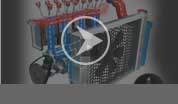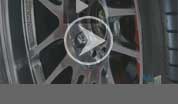Category Archives: Monitoring System
TPMS: Tire Pressure Monitoring For Your Des Moines Auto
Des Moines car owners may know that all 2008 model year and newer cars, mini-vans and light trucks in Des Moines come with a tire pressure monitoring system. Many slightly older vehicles around Altoona have these systems as well. A tire pressure monitoring system – called TPMS – consists of sensors on each wheel that measure tire pressure.
If tire pressure drops 25 percent below the auto manufacturer’s recommended pressure, the sensor sends a signal to a monitoring unit that causes a warning to light up on the dashboard. When Altoona motorists see the warning light, they know it’s time to put some air in the tires.
There are many benefits to Des Moines motorists who drive with properly inflated tires around Des Moines. First is cost savings. Running at the correct air pressure improves MPG. Driving on under-inflated tires is like driving through sand – it drags down your gas mileage. Des Moines drivers will also see longer, more even tread wear so your tires’ll last longer.
Another important benefit of properly inflated tires is increased safety for Des Moines auto owners. Under-inflated tires become hotter and that heat can actually lead to tire failure – possibly resulting in an accident. Your car and the tires themselves will just perform better and more safely around Des Moines with properly inflated tires.
Local Des Moines consumer groups, law-makers and auto manufacturers advocate TPMS systems hoping that they will save lives, property damage and inconvenience. While you can’t put a value on saving a life, Des Moines drivers should keep in mind that TPMS systems aren’t free.
The systems themselves are added into the price of the car. The batteries in the sensors will have to be replaced from time to time. Parts will break and need to be replaced. In colder climates around IA, ice and salt are frequent causes of failure.
In addition, there are other behind-the-scenes costs we want Des Moines car owners to be aware of. Every time a tire is replaced, repaired, rotated or balanced, the tire technician has to deal with the TPMS system.
Des Moines service centers such as Des Moine BDG must purchase pricey equipment used to scan and reactivate the TPMS system after every tire service. Because older tire change equipment can damage TPMS sensors, your Altoona service center may need to buy expensive, new tire changers.
Since there is no uniformity among car makers, service advisors need to be trained on several TPMS systems. These behind-the-scenes costs are very real to Des Moines service center managers like Des Moine BDG BDG at Des Moine BDG.
That’s why the team at Des Moine BDG is anxious for Altoona car owners to understand the critical financial impact of TPMS systems. In the past, we’ve been able to quickly and cheaply provide tire services to car owners, and then pass the low cost on to Altoona customers as an expression of our good will. But now even these simple jobs take much longer and require expensive equipment.
Sensors will need to be removed and reinstalled. Even a tire rotation will require that the monitor be reprogrammed to the new location of each tire. When a car battery is disconnected, the TPMS system will need to be reprogrammed.
So when you start so see the cost of tire changes, flat repairs and rotations going up in IA, please keep in mind that it’s because of this critical new safety equipment. The team at Des Moine BDG just wants to keep you safely on the road – and we’re committed to doing it at a fair price.
It’s critical to remember that the TPMS warning only comes on when a tire is severely under-inflated. You’ll still want to check your tire pressure regularly. At every fill-up is best, but you should check pressure at least once a month. Here’s wishing you safe travels.
Contact Des Moine BDG for more important information about Tire Pressure Monitoring Systems.
Why is My Check Engine Light On?
The Check Engine Light strikes fear into the hearts of some Des Moines auto owners and is totally ignored by just as many. Just what it means is a mystery to most of us Des Moines drivers.
Let’s get the urgency issues out of the way first. If your check engine light is flashing, that means that something is wrong that could cause essential engine damage. Naturally, you need to get that taken care of right away. If your check engine light is flashing, you shouldn’t drive at IA expressway speeds, tow or haul heavy loads. Take it easy all the way to your Des Moines service center.
If the light is glowing steadily, you should keep an eye on it for a day or two. If the light doesn’t go off, schedule an appointment with your helpful Des Moine BDG service advisor to get it checked out.
Some more Des Moines information on how the Check Engine Light works may be informative for Des Moines drivers. Most of your engine functions are controlled by a computer, not surprisingly, called an engine control computer. The computer is able to adjust many engine parameters for environmental conditions, engine condition and even the way you drive.
In order to make these adjustments, the computer relies on a network of sensors to provide data. The computer knows the proper operating range for each sensor. When a sensor reading is out of range the computer runs some tests and may turn on the minivan’s Check Engine Light.
A simple example is a loose or missing gas cap. This may cause one of the sensors to read out of range. The computer doesn’t know if it’s a serious condition that caused the reading or just a loose gas cap, so it stores a trouble code and turns on the Check Engine Light.
Now when you tighten up the gas cap the sensor readings will be in the correct range. The computer will keep checking on the report for a day or two. Since a bad reading didn’t come up again, it turns off the Check Engine Light. The computer will also try to make adjustments to compensate for some readings. If it can do so, it’ll then turn off the Check Engine Light.
If the problem can’t be resolved then the light will remain on and you should get your minivan looked at. Your helpful Des Moine BDG tech will plug a scanner into the on-board diagnostic port and read the trouble code stored in the computer. The trouble code will give the technician a starting place as he diagnoses the cause of the problem.








